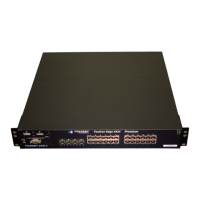Configuring Basic Software Features
December 2005 © Foundry Networks, Inc. 3 - 13
Configuring Basic Port Parameters
The procedures in this section describe how to configure the port parameters shown in Table 3.5
All Foundry ports are pre-configured with default values that allow the device to be fully operational at initial
startup without any additional configuration. However, in some cases, changes to the port parameters may be
necessary to adjust to attached devices or other network requirements.
Assigning a Port Name
A port name can be assigned to help identify interfaces on the network. You can assign a port name to physical
ports, virtual interfaces, and loopback interfaces.
To assign a name to a port:
FESX424 Router(config)# interface e 2
FESX424 Router(config-if-e1000-2)# port-name Marsha
Syntax: port-name <text>
The <text> parameter is an alphanumeric string. The name can be up to 64 characters long. The name can
contain blanks. You do not need to use quotation marks around the string, even when it contains blanks.
Modifying Port Speed
The Gigabit Ethernet copper ports on the FESX and FWSX are designed to auto-sense and auto-negotiate the
speed and mode of the connected device. If the attached device does not support this operation, you can
manually enter the port speed to operate at either 10 or 100 Mbps. The default value is 10/100/1000 Auto-sense.
NOTE: You can modify the port speed of copper ports only. This feature does not apply to fiber ports.
Table 3.5: Basic Port Parameters
Port Parameter See Page
Name 3-13
Speed 3-13
Auto-negotiation Maximum port speed
advertisement and Port speed down-shift
3-14
Duplex mode 3-15
MDI/MDIX detection 3-16
Port status (enable or disable) 3-16
Flow control 3-17
Gigabit negotiate mode 3-17
QoS priority 3-17
Dynamic configuration of Voice over IP (VoIP)
phones
3-17

